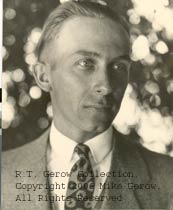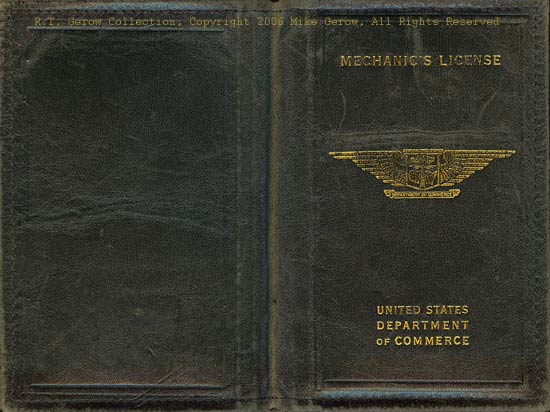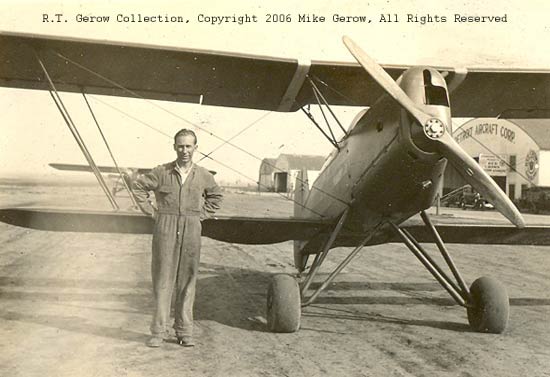Russell T. Gerow, 1933
 |
Most of the text complementing this section was written by Russell T.
Gerow's son, Mike, who also shares these images with us.
He wishes to dedicate this section of the Davis-Monthan Airfield
Register web site to the memory of his father on behalf of
his brother, Stephen Bradley Gerow, and sister, Ann Worthen
Gerow. I'm extremely happy to do this.
At right, Russell T. Gerow sitting on a Ford sometime during 1933. Details in the original photograph show interesting dark-rimmed sun glasses with round lenses, and a gold link watch band. The license plate is from California, 1933.
Although he never signed the D-M Airfield Register, it is
possible that Russell T. Gerow--pilot, aerial
photographer and aviation mechanic--passed through Tucson
at some point during an aviation career that very nearly
paralleled the 1925 - 1936 dates of the Airfield Register
itself.
He worked for Continental Air Map, Inc. The next two images
show him in that capacity, "on the job".
Russ Gerow manning photographer's station
of the company's Douglas M-4, Long Beach, CA ca. 1930-33.
He constructed a
middle cockpit which included an airborne dark room for developing
film literally on the fly
 |
During
his peak years in the field, primarily at Long
Beach, California, Gerow amassed a collection of several
hundred images, a portion of which featured personalities,
aircraft and locations directly related to the Davis-Monthan
story. Some
of these images are presented in this online Collection.
Continental Air Map Co. crew
Left to right: Joe
Mountain, pilot; Russ Gerow, photographer/mechanic; Dick
Kerr, navigator. Picture taken at Long Beach, ca.1930-33
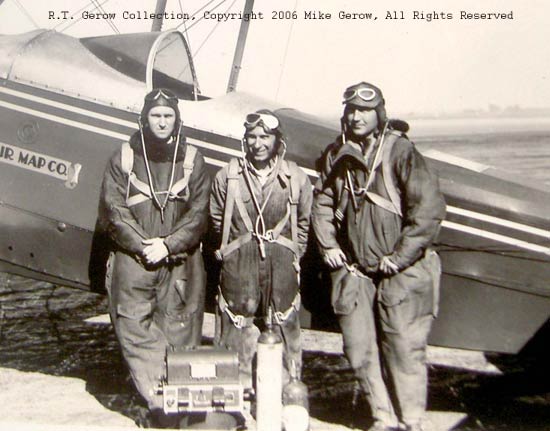 |
Around this time, Continental Air Map secured a contract
with Standard Oil of Calif (Socal) to conduct geological
exploration of the Arabian peninsula by air. The old Long
Beach team of Kerr, Mountain and Gerow flew together again
from September 1934 to mid-1935 in the company's single-engine
Fairchild 71 (NC13902). They were among the first two dozen
westerners ever to set foot in al-Hasa, as eastern Arabia
was then called, and they were the first to map its 320,000
square miles from the air. Their efforts directly led to
the discovery of the vast Arabian oil fields that
changed the face, and pace, of the world as we know it.
Berryloid Handbook, 1929, Front Cover
 |
From this period, Mike presents this artifact of his father's work. It is a handbook from the Berry Brothers Company. An image of the cover is at left. Berry Brothers manufactured and sold a wide range of aircraft finishes under the trade name Berryloid. The book presents shop methods for finishing fabric-covered aircraft and its metal structures.
Mike says about the handbook, "It is an original copy of the Fourth Edition Berry Brothers 'Specification for Aircraft Finishing,' dated June 1929." Coincidentally, company president Thomas Berry Colby was a Register pilot. Please direct your browser to his page to view some color samples of Berry Brothers products.
Although a little yellowed and water stained, the book is in excellent shape. It even preserves, on page 25, an intact, perforated tear-off questionnaire.
Berryloid Handbook, 1929, Page 19
 |
Mike further points out, "... some marginal notations and paragraph highlighting that were inscribed by my Dad, no doubt during his employment with Continental Air Map Company at Long Beach Airport. Almost certainly this little booklet accompanied [him] on the 1934 Arabian aerial survey ...." The notations can be seen in red and blue pencil on page 19 of the handbook, shown at right. Many other pages are similarly highlighted, indicating a close study of the methods.
The entire document can be downloaded from the link (PDF 10Mb, 25 pages). It is worthwhile to point out, as strange as it might seem, that the techniques for finishing fabric covered aircraft have changed little in the past 80 years.
Image below shows Russ Gerow in his photographer role in the back
of a Fairchild F-71 modified for aerial photography.
Note camera mounted to shoot vertically through floor bottom
and telegraph key halfway up door frame at right edge. This
image was taken in eastern Saudi Arabia, winter 1934-35.
Please direct your browser to this link to
see some of the earlier aerial images he took.
Continental Air Map crew in Saudi Arabia, winter 1934-35.
Left to right, Joe Mountain, pilot; Dick Kerr, navigator;
Russ Gerow, photographer/mechanic
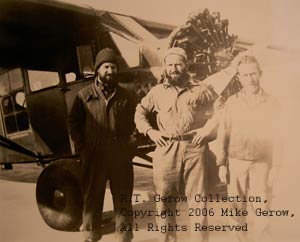 |
Image, left, taken in eastern Saudi Arabia, winter
1934-35. Note massive balloon sand tires and six-pane
sash window enclosing photographer's station shown in photo
above.
---o0o---
Russell Templeton Gerow was
born November 13, 1897 in Hanford, King's County, CA, the
son of Canadian-born Ichabod Bowerman Gerow and Sarah Edith
Bradley. Gerow's maternal kin, the Bradleys and Allens, were
frontiersmen and wagon train pioneers from Kentucky and Missouri
who had scaled the Sierra cliffs just two weeks ahead
of the snows that trapped
the ill-fated Donner Party in 1846. Ick, as Russ's father
was called, was a master carpenter and rancher who bounced
around California's Central Valley chasing work in the early
1900s. Russ's formal education ended after the 10th
grade, when he entered the work force to boost the family
income. His first job at age 13 was apprentice auto mechanic
at the Studebaker garage in Dinuba, CA.
He learned to fly in he mid-1920s, before licensing of pilots was manadatory. In the mid-1930s he acquired a legal license. Below, his permit to "learn" to fly. The paperwork was just a formality at this time. Mike Gerow says about this document, "My dad took instruction from [Milo] Burcham at Long Beach using this document, which was issued Jan’y 26, 1932. When [he] learned to fly in the mid-1920s, pilot’s licenses were not yet required. This had obviously changed by the time of his employment with CAM Co. at LGB [Long Beach] c. 1928-32. It is possible that he desired or needed to get his license for job reasons, but we’ll never know."
R.T. Gerow Student Pilot Permit, January 26, 1932 (Source: Gerow)
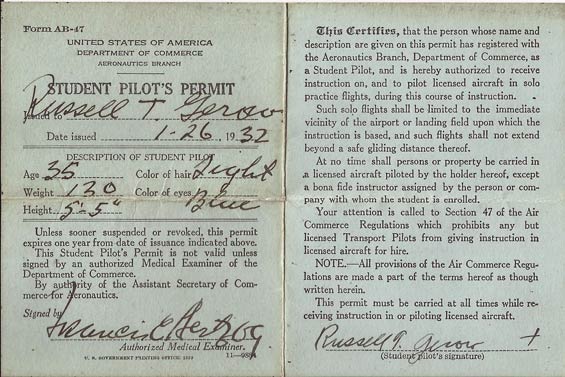 |
Further, "The medical examiner was Dr. Francis C. Hertzog, who unfortunately was not a D-M register signatory, either as pilot or passenger. I did, however, find an obit for the good doctor’s son, junior, who passed away this past February [2011]. Interestingly, Dr. Hertzog, Jr. was a commercial pilot, member of the Long Beach Airport Commission and a second-generation FAA medical examiner. I just include this out of passing interest, since Dr. Hertzog, Sr. was the medical examiner for the Long Beach area during at least a part of the D-M era.... Unfolded, the permit measures exactly 4” x 6” and is blank on the reverse."
Gerow's early mechanical aptitude led to another of his specialties
as an
aviation mechanic. Below are the leather cover and the interior
of his certificate. This license expired in 1938 and the
certificate is voided. Contemporary mechanic licenses (Airframe & Powerplant
certificates) are good for life (or until revoked).
R.T. Gerow Mechanic's License, 1928
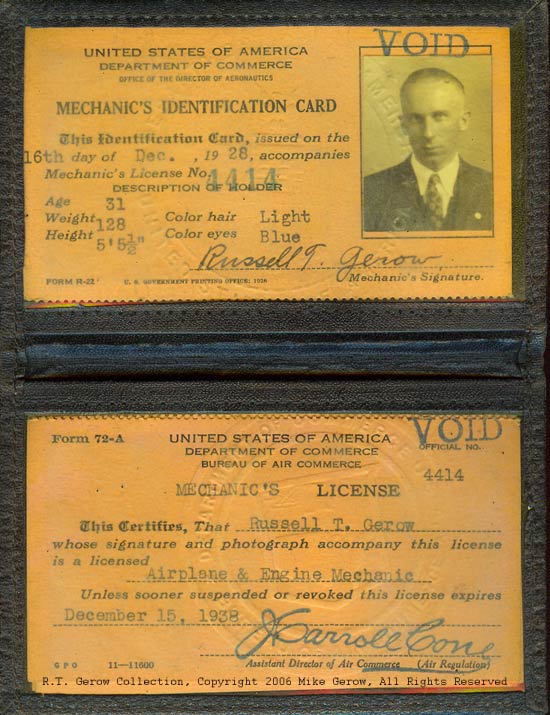 |
---o0o---
22-year-old Corporal R.T. Gerow, 397th Motor Transport
Company out of Camp Marfa, Texas, supporting 15th Cavalry
on the Mexican border, 1920
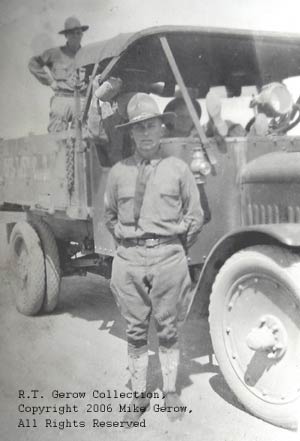 |
In 1918, he enlisted in the Army and was posted as
a truck mechanic with the 397th Motor Transport Company at
Camp Joseph E. Johnston in Jacksonville, Florida. Before
they could ship to France, the war ended and his unit was
instead sent in 1919 to Camp Marfa, Texas, to support
the 15th Cavalry along the Mexican border. Gerow attained
the rank of corporal in command of a five-man White lorry.
By the mid-1920s, his family had relocated
to Taft, a wild and wooly oil boom town in the southern
San Joaquin Valley. Russ bought a Thomas-Morse S4C Scout
(80 hp LeRhone rotary), a popular WW1 surplus fighter trainer
and, under the tutelage of ex-Army pilot Dave Matthews, soloed
it in June 1925.
While in Taft on business, Dick Kerr, ex-Navy
pilot, California geologist (U.C. Berkeley) and half owner of
L.A.-based Continental Air Map Co., observed Gerow's beautifully
restored Tommy flying low up the main drag of town and
followed it out to the airfield. After a short discussion,
Kerr offered Gerow the job of mechanic at Continental
Air Map, then operating a Liberty-powered DH-4B (R-3494)
out of Long Beach Airport.
Below, Russ Gerow running up Continental's
DH-4B circa 1929. This image typifies the unglamorous daily
grind of all the aviation mechanics
who kept their charges, both civilian and military, running
in tip-top condition. The airplane, 3494, is not in the Register.
The EMSCO Aircraft hangar in the background suggests this
image was snapped at Downey, CA.
Russ Gerow and DH-4B, ca. 1929
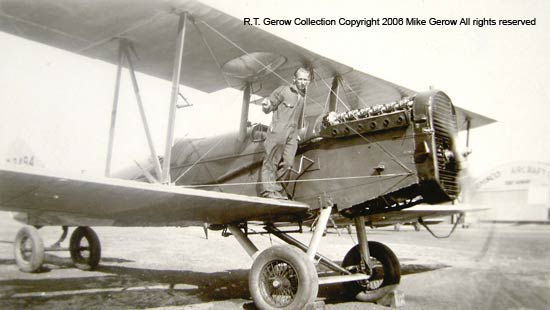 |
We salute every unknown, unsung "grease
monkey" whose
applied knowledge and skill literally meant the difference
between life and death. Not only for the pilots who signed
the Register over the years, but for their many passengers
who, with scarcely a passing thought, flew safely on to their
destinations, lived another day and, in most cases, passed
into obscurity. Russ Gerow puts a face on all those behind
the scenes, in the hanger and on the flight line, who kept
them flying..
---o0o---
Below, Gerow with a Curtiss Robertson Robin.
This could be the same airplane (NC7499) as exhibited about
ten images down on this page.
R.T. Gerow with Curtiss Robertson NC7499,
exact date
and location unknown but probably Taft, California ca.
1928
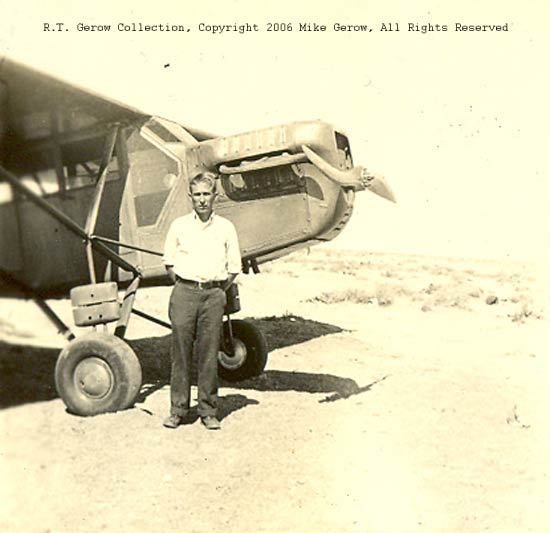 |
---o0o---
Gerow remained with Continental Air Map for
approximately four
years starting in 1928, during which time he became skilled in
the art of aerial photography. In 1930, Continental bought
Western Air Express's long-wing Douglas M-4 (NC1475) that
Bart Cox had ground-looped at Alhambra. Gerow rebuilt
the ship, adding Bendix brakes and a middle cockpit that
also contained an aerial darkroom. This ship was used to
map Bryce, Zion and Cedar Breaks in southern Utah, as well
as other jobs in the western states for the U.S. Deptartment
of the Interior. (After changing hands several more times,
Western Air Lines restored it in 1976 as a short-wing M-2
in WAE livery (C150) and flew it to Washington
D.C. to its permanent place in the NASM's Hall of Transportation.)
Below, R.T. Gerow with the one-off Earl Populaire,
date unknown, but after 1929.
---o0o---
Below, Gerow with Milo
Burcham and Bird BK NC48K.
This Bird landed at the Davis-Monthan Airfield on November
12, 1929 as a flight of two with another Bird NC28K. See
this link to
learn the circumstances around that flight. Burcham later owned
the airplane in Long Beach.
R.T. Gerow (R), Milo Burcham & Bird NC48K
 |
Continental's hanger at Long Beach was next to Gladys
and Lloyd O'Donnell's school of aviation, whose chief instructor
was Milo Garrett Burcham of later Lockheed fame. The O'Donnell
School of Aviation was run by famed race pilot and charter
member of the Ninety-Nines Gladys O'Donnell and her husband,
Lloyd. Russ Gerow, working in Continental’s
hanger, would occasionally bellow out that famous Enrico
Caruso lyric, "O solo
mio!" to which Milo, in his own hanger, would sing back
just as loudly, "I would if you had the time!
Enlargement from Image Above
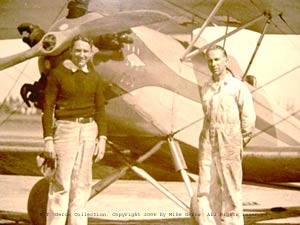 |
Long Beach Airport would often get socked in by dense coastal
fog. Milo Burcham, however, had discovered that one corner
of the field usually remained clear. So he devised a little
trick in which he would land at that corner, then taxi his
plane right up to his own hanger and shut her down as though
it were a perfectly sunny day.
After doing this several times, people got to thinking that
Milo had some kind of supernatural powers that allowed him
to see through fog so thick that everyone else had trouble
seeing their own hands at arm's length. Curiosity finally got
the better of Russ, who took Milo aside and asked him how he
did it. Milo told him about the clear corner of the field and
how he used tachometer, compass and clock to taxi by pure dead
reckoning back to the hanger. Milo couldn't see through the
fog any better than anyone else, but he was awfully smart and
his little trick perfectly illustrates his fun-loving spirit,
audacity and talent for precision flying -- even on the ground!
While giving advanced aerobatic instruction
on 12 Oct 1931, Burcham's Bird BK
entered an unrecoverable flat spin and crashed into a freshly
plowed field at El Monte, Calif. Though the plane was completely
destroyed, the occupants emerged unscathed. According to
Russ, Milo's young student (identified years later by Eddie
Martin as Vinetta Sloan), said," Milo, aren't you going
to get out?" Burcham, still completely stunned, replied, "I...know...I'm...dead."
EMSCO supervisor
Don Feather gave Burcham free use of space
and materials in the Downey plant, where Gerow completely
rebuilt NC48K from the ground up using "beautiful Chromalloy
tubing," as he recalled. The phoenix-like re-emergence
of NC48K was memorialized in the photographs above and below,
ca. 1932.
Gerow in Brunner Winkle Bird NC48K, ca. 1932
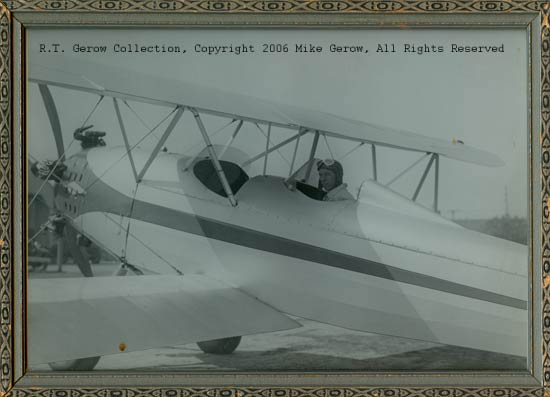 |
Rear of the above image.
Data on Photo Reverse
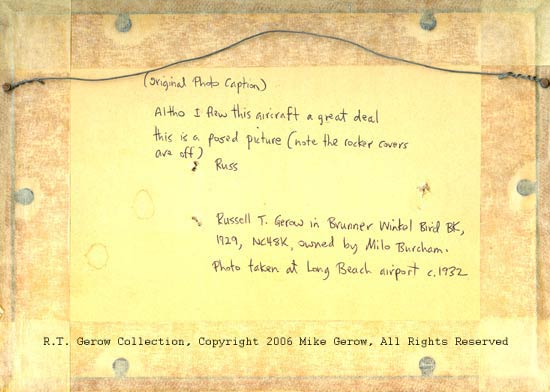 |
---o0o---
Russ Gerow held several other aviation jobs in the 1920s
and 1930s, the exact chronology of which is unclear. He was
a mechanic for Wilmington-Catalina Airlines' Douglas
Dolphin (NC12212) and Loening C-2C Air Yacht (NC9772) through
the summer of 1932 to at least the end of the following
January. At one point he worked for Hollywood stunt
pilot Garland Lincoln rigging airplane crashes for the movies.
In September 1933, we find him at Douglas in Kansas City,
where his suggested improvements were incorporated in the
DC-1 ignition harness. While at Kansas City, Milo Burcham
passed through town with the Boeing 100 (872H) that he had
just bought from P&W in Hartford, Conn. Learning of Burcham's goal
to recapture the world's inverted flight endurance record,
Gerow suggested that he invert the engine since it
was only held on by four bolts. The suggestion was followed.
Back home from the Middle East in late 1935, Gerow left Continental Air Map and aviation for good. Soon after hiring on as a tool-and-die maker with Superior Oil Company, he participated in the first ever seismic exploration in California at Bakersfield in 1936. Reenlisting in the Army in 1942, he trained in optics and mathematics at Aberdeen Proving Ground but was released from the military in 1944 to run a secret, experimental machine shop at CalTech, where his work included machining the trigger mechanisms for the atomic bombs that ended World War Two with a bang. Although confirmation is now impossible because the principals are gone, it is highly probable that Gerow's sudden release from active duty was precipitated by use of the Manhattan Project's magic code phrase of "Silver Plate" by Bob Moran, Jr., the engineer in charge of the R&D shop tasked with designing and producing these critical weapon components.
In 1962 Gerow retired from Superior Oil Co. after 27
years as an instrument maker for the company's exploration
and drilling operations. For the next 20 years, he worked
with legendary inventor Francis L. Moseley who
is credited with devising the ADF, VOR and ILS aircraft
instruments, among others. In his seventies and early
eighties, Russ built a live-steam locomotive, a 4-6-2 "Pacific" type,
which he described as "equivalent in effort to building a
house." Born on November 13, 1897, he died at Alhambra,
Calif. on June 13, 1993, age 95 years seven months.
Russ Gerow's participation in three earth-changing
events of the 20th century--Aviation's Golden Age, the Saudi Expedition
and the Manhattan Project--would not be considered unusual
or remarkable to the generation of men and women celebrated by
the Davis-Monthan Airfield Register web site. Like many of his
time, Russ Gerow's somewhat austere rural upbringing
steeled him for a life of hard work that was characterized
in his case by a high degree of mechanical aptitude,
technical skill and a quiet dependability that
became his lifelong trademark. He was humble, calm
and deliberate--the kind of guy who acted like
he never really knew what all the fuss was
about.
---o0o---
UPLOADED: 11/16/06 REVISED: 11/21/06, 11/29/06, 12/08/06, 01/18/08, 02/10/08, 01/29/09, 07/20/11,10/08/11
|

